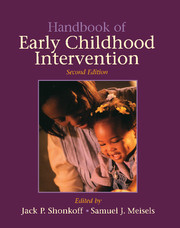Book contents
- Frontmatter
- Contents
- Foreword
- Preface
- Contributors
- PART ONE INTRODUCTION
- PART TWO CONCEPTS OF DEVELOPMENTAL VULNERABILITY AND RESILIENCE
- 2 The Biology of Developmental Vulnerability
- 3 Adaptive and Maladaptive Parenting: Perspectives on Risk and Protective Factors
- 4 The Human Ecology of Early Risk
- 5 Cultural Differences as Sources of Developmental Vulnerabilities and Resources
- 6 Protective Factors and Individual Resilience
- PART THREE THEORETICAL FRAMEWORKS FOR INTERVENTION
- PART FOUR APPROACHES TO ASSESSMENT
- PART FIVE SERVICE DELIVERY MODELS AND SYSTEMS
- PART SIX MEASURING THE IMPACT OF SERVICE DELIVERY
- PART SEVEN NEW DIRECTIONS FOR THE TWENTY-FIRST CENTURY
- Name Index
- Subject Index
5 - Cultural Differences as Sources of Developmental Vulnerabilities and Resources
Published online by Cambridge University Press: 05 November 2011
- Frontmatter
- Contents
- Foreword
- Preface
- Contributors
- PART ONE INTRODUCTION
- PART TWO CONCEPTS OF DEVELOPMENTAL VULNERABILITY AND RESILIENCE
- 2 The Biology of Developmental Vulnerability
- 3 Adaptive and Maladaptive Parenting: Perspectives on Risk and Protective Factors
- 4 The Human Ecology of Early Risk
- 5 Cultural Differences as Sources of Developmental Vulnerabilities and Resources
- 6 Protective Factors and Individual Resilience
- PART THREE THEORETICAL FRAMEWORKS FOR INTERVENTION
- PART FOUR APPROACHES TO ASSESSMENT
- PART FIVE SERVICE DELIVERY MODELS AND SYSTEMS
- PART SIX MEASURING THE IMPACT OF SERVICE DELIVERY
- PART SEVEN NEW DIRECTIONS FOR THE TWENTY-FIRST CENTURY
- Name Index
- Subject Index
Summary
Developmentalists have had an ongoing, albeit uneasy, relationship with the constructs of culture, ethnicity, “race,” and minority status (Cole, 1996; Duckitt, 1992). As their influence becomes recognized, these constructs have often proved difficult to conceptualize and even harder to incorporate as key sources of influence in all children's lives. This has led some academics and clinicians to ignore their role in human development, and others to inappropriately apply these constructs peripherally to their work; whereas a few academics and clinicians have placed these constructs at the core of their research questions and service delivery.
The push to understand the role of culture in children's development began in the middle of the twentieth century with the work of such anthropologists and cross-cultural psychologists as John and Beatrice Whiting (Whiting & Whiting, 1975), Robert Levine (Levine, 1977), and Michael Cole (Cole & Bruner, 1974; Cole, 1996), followed more recently by Sarah Harkness and Charles Super (Super & Harkness, 1980), as well as Barbara Rogoff (Mistry & Rogoff, 1994; Rogoff & Morelli, 1989), among others. Unfortunately, though well regarded in its own niche, this work has been relegated to the margins of mainstream developmental work (García Coll & Magnuson, 1999b; Slaughter-Defoe, Nakagawa, Takanishi & Johnson, 1990). Most developmentalists have continued to pursue implicit universal trends and truths; this detracts from our understanding of phenomena that are culturally bound and the influence of other sociocultural factors on development, thus affecting programming efforts on behalf of children and their families.
- Type
- Chapter
- Information
- Handbook of Early Childhood Intervention , pp. 94 - 114Publisher: Cambridge University PressPrint publication year: 2000
- 43
- Cited by

